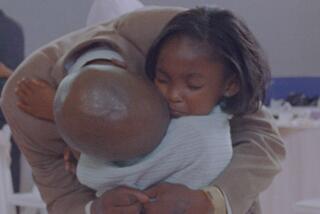‘Working Fathers’: More Responsibilities, More Pressures
Until recently, the needs of working fathers have been buried under an avalanche of publicity about working mothers. After all, even the term “working father” appeared redundant in light of men’s traditional family role.
But there’s a growing body of evidence that men are just as stressed out as women by the effort to juggle work and family. Although women’s entrance into the work force required men to take on more at home, men have yet to receive much attention for their struggles to balance domestic responsibilities with their jobs.
“There’s a larger percentage of dads today dealing with work and family conflict than anyone realizes, but they are reluctant to talk about it,” said James A. Levine, director of the Fatherhood Project at the Families and Work Institute and co-author of “Working Fathers” (Addison-Wesley, 1997).
These changing priorities were voiced by about two-thirds of 2,000 male respondents to a recent survey by Catalyst Inc., a New York nonprofit group, who said they either valued family over work or considered the two equally important.
In addition, the best predictor of men’s health is what’s going on with their kids, rather than what’s going on at the office, according to a study of 300 two-earner couples reported in “She Works, He Works” (HarperCollins, 1996).
“The current wisdom is that men’s experience on the job is the primary cause of their health problems,” said Rosalind Barnett, the book’s co-author and a senior scholar in residence at the Murray Research Center of Radcliffe College. “But people who say this don’t ask men about their families.”
A majority of calls and letters received by the monthly newsletter Work and Family Life are from men, said Susan Ginsberg, the New York-based newsletter’s editor and publisher and author of “Family Wisdom” (Columbia University Press). The newsletter is distributed to about 50,000 employees at more than 200 companies.
Increasingly, working fathers are part of a two-earner couple. Today, about 66% of all couples both work full time. Only 14% of all households now have a married couple with a single male earner, said Kathleen Gerson, a professor of sociology at New York University and author of “No Man’s Land” (BasicBooks, 1993).
Fostering what Levine calls an “evolution, not a revolution” is not going to be easy. Men continue to face huge obstacles to being egalitarian fathers. Perhaps the most significant roadblock is societal stereotypes that play themselves out both at work and at home.
“When a woman works outside the home, our society assumes that she must feel a constant tug of war between her job self and her parent self,” wrote Levine and co-author Todd L. Pittinsky in “Working Fathers.” He added: “The prevailing assumption is that men do not feel that tug of war.”
More often than not, the media perpetuate these stereotypes, reinforcing the belief that women hold the primary responsibility for taking care of their families.
“The bulk of stories still focus on how women can do it all,” Gerson said. “This has two pernicious effects. For men who don’t want to be involved, it lets them off the hook, and it ignores those who do and makes it difficult for society to accept them.”
Often when the media do focus on working fathers, they sensationalize the experiences of those who have chosen to stay at home full time with their children while their wives work. Such a perspective ignores the 91% of fathers with children under 18 who remain in the paid labor force.
Until recently work and family clashes were an “invisible dilemma” for men who felt threatened by corporate cultures that don’t allow a man to admit he has child-care responsibilities.
Although more men are speaking out about their conflicts, few feel empowered to tell the boss that they have to leave early to go to a Little League game or even that they would like to take time at home with a new baby.
“It’s fairly common for fathers to take a few days off at the time of a child’s birth, but they rarely request this time as a separate paternity leave,” a report from another Catalyst study said. “More often, men use their vacation days or arrange to take the time off informally as paid or unpaid days.”
Men take a similar approach when they need to stay at home with a sick child, fearing that the truth might be interpreted by their supervisors as a desire to avoid work, Gerson said.
Some companies are starting to pay attention to this conflict, although this awareness is not yet widespread. Chase Manhattan Bank began a fatherhood program earlier this year. Marriott also has one.
The Los Angeles Department of Water and Power, a pioneer of fathering programs, launched DWP Dads as part of a larger family care plan in 1991. About 131 men participate in the program, which provides support and information to dads.
“Imagine what would be a mother’s concern. It’s the same thing for dads,” said Eric Cyrs, director of DWP Dads.
The program has helped fathers cope and has boosted their morale. It also has been beneficial for the company.
“According to an evaluation we did of the fathering program, participants had a lower instance of absenteeism and tardiness and were more productive,” Cyrs said.
All this is not to say that most men have backed away from their traditional role as breadwinner, despite the fact that 31% of the women in dual-earner couples make more than their husbands.
“Fathers in my studies indicated their most important function as a father was that of providing economic security for the family, even when they are making less money than their spouse,” said Robert Midkiff, a psychologist and assistant dean of the College of Arts and Sciences at Bucknell University in Lewisburg, Pa.
Men, of course, aren’t a homogenous group. So even though there’s a trend in one direction for more men to be more involved at home, there’s also a growing number of deadbeat dads and estranged fathers, Gerson said.
“We have two things happening here. We have the emergence of a group of men for whom greater equality means more commitment at home,” Gerson said. “Then we have a group of men moving away from family life in reaction to a decline in their economic fortunes and a rise in women’s opportunities.”
Until corporations and society stop defining work and family as separate spheres for both men and women, experts agree it will be difficult for everyone to find an adequate balance between the two.
“We need to start seeing this as a parent problem in order to develop a better means for coping,” Gerson said. “Ordinary parents have to start organizing and lobbying and making it clear these are legitimate needs and rights.”
More to Read
Sign up for our Book Club newsletter
Get the latest news, events and more from the Los Angeles Times Book Club, and help us get L.A. reading and talking.
You may occasionally receive promotional content from the Los Angeles Times.










